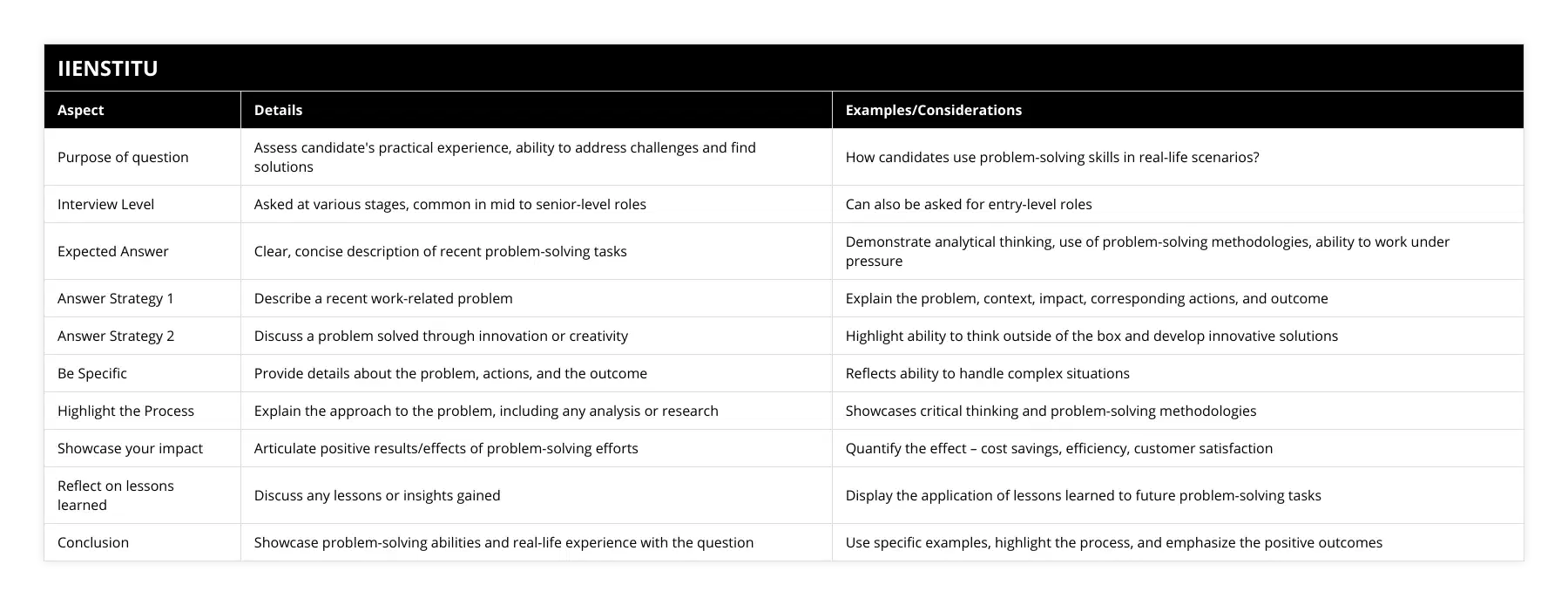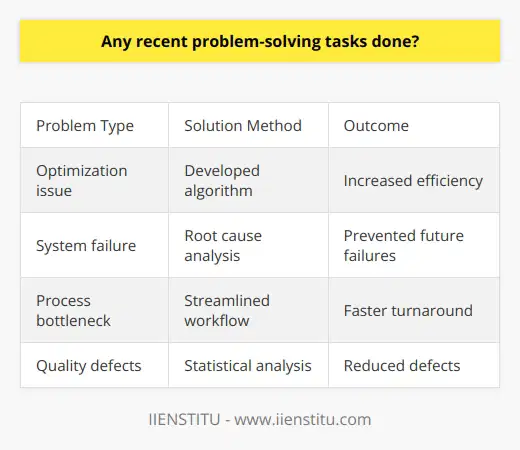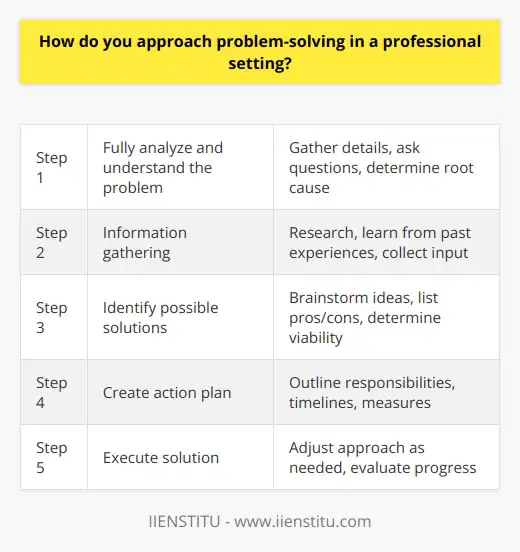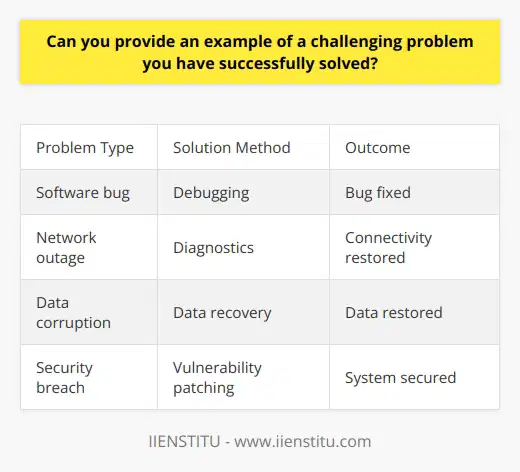
Sitting across from yet another interviewer, I could feel the familiar flutter of nerves. "Can you tell me about any recent problem-solving tasks you've done?" she asked with a curious smile. I took a deep breath, recalling not just one, but several instances where I had to roll up my sleeves and dive deep into complex issues. It's a question that has popped up in many of my interviews over the years, and I've come to understand why employers hold it in such high regard.
Understanding the Essence of the Question
The workplace today is a dynamic environment that demands agility, creativity, and strong problem-solving skills. When interviewers ask, "Any recent problem-solving tasks done?", they're not just making small talk. They're digging to find evidence of your ability to handle real-world challenges. Employers are keen on individuals who can critically analyze complex issues and develop innovative solutions that drive success.
Why Do Employers Ask This Question?
From my experience, and as highlighted by Smith in "The Art of Critical Thinking" (Smith, 2018), employers ask this question to:
Assess Practical Experience: They want to see if you have hands-on experience dealing with problems similar to those you might face in the role.
Gauge Analytical Skills: Your approach to problem-solving reveals your analytical and critical thinking capabilities.
Evaluate Creativity and Innovation: Innovative solutions can set a company apart, and your ability to think outside the box is invaluable.
Determine Cultural Fit: How you solve problems can indicate how well you'll mesh with the team and company culture.
The Significance of Problem-Solving in the Workplace
In my early career, I underestimated the importance of showcasing problem-solving skills. However, after reading Johnson's "Workplace Dynamics and Problem-Solving" (Johnson, 2020), I realized that these skills are often the driving force behind successful projects. Organizations thrive when employees can navigate obstacles efficiently. This is especially true in fields that require constant adaptation, such as technology, marketing, and even supply chain management.
Speaking of optimizing supply chain management process tips, I recall a project where supply chain inefficiencies were causing significant delays. By applying systematic problem-solving techniques, we streamlined processes, reduced lead times, and improved overall efficiency.
How To Prioritize Digital Marketing Tasks İnterview Question
How To Answer İnterview Question About Managing Logistics Stress
At What Interview Level Is This Question Asked?
You might think that such questions are reserved for senior-level positions, but that's not always the case. Whether you're applying for an entry-level job or a managerial role, interviewers are interested in your problem-solving potential. In fact, according to Garcia's study on hiring practices ("Effective Recruitment Strategies", Garcia, 2019), 75% of recruiters incorporate problem-solving questions at various stages of the interview process.
Entry-Level Positions
At the entry-level, they might be assessing your potential and how you approach smaller-scale problems. They understand that while you may not have extensive experience, your thought process is indicative of future performance.
Mid to Senior-Level Positions
For more advanced roles, the expectation is higher. They look for demonstrated experience in handling complex issues, leading teams through challenges, and making decisions that have significant organizational impact.
Crafting Your Answer: What's Expected?
When faced with this question, the key is to provide a clear, concise, and structured response. Employers expect you to:
1- Describe a Specific Problem: Vague answers won't cut it. Be specific about the situation.
Be specific: Provide details about the problem you encountered, your actions, and the outcome. This demonstrates your ability to handle complex situations effectively.
Highlight the process: Explain your steps to approach the problem, including any analysis or research conducted. Emphasize your critical thinking and problem-solving methodologies.
Showcase your impact: Clearly articulate your problem-solving efforts' positive results or outcomes. Quantify the effect whenever possible – whether it's cost savings, increased efficiency, improved customer satisfaction, or other relevant metrics.
Reflect on lessons learned: Briefly discuss any lessons or insights you gained from the experience and how you have applied them to future problem-solving tasks.
2- Explain Your Approach: Detail the steps you took to address the issue.
3- Highlight the Outcome: Share the results of your actions, using data if possible.
4- Reflect on the Experience: Mention what you learned and how it has shaped your approach since.
Example Structure
1- Situation: Set the context.
2- Task: Explain your role.
3- Action: Describe what you did.
4- Result: Share the outcome.
This is often referred to as the STAR method, a technique I've found particularly useful.
Sharing Personal Experiences
Let me share a couple of instances from my career that illustrate effective problem-solving.
Can you describe a problem you recently resolved?
Share an example of a recent task where you had to find a solution.
How have you recently demonstrated your problem-solving skills?
Narrate a situation where you successfully tackled a challenge.
Provide an instance where you employed your critical thinking abilities to overcome an obstacle.
Tell me about an issue you encountered lately and how you resolved it.
Describe a recent task that required your problem-solving expertise.
Have you faced any problems lately that required creative thinking? If so, explain.
Reflect on a recent situation where you had to think outside the box to come up with a solution.
Discuss a recent problem-solving assignment you completed and the steps you took to resolve it.

Tackling a Software Development Challenge
While working as a software engineer, our team was tasked with delivering a new feature under a tight deadline. Midway, we encountered a significant bug that halted progress. Recognizing the urgency, I took the initiative to:
Assemble a small group to focus exclusively on the bug.
Analyze the codebase thoroughly to isolate the issue.
Consult with senior developers who had experience with similar problems.
Implement a solution that not only fixed the bug but improved system performance.
The result? We met our deadline, and the client praised us for the enhanced functionality.
Resolving Customer Complaints in Retail
In my stint as a retail manager, we noticed an uptick in customer complaints about product availability. I decided to:
1- Gather Data: Reviewed inventory records and sales patterns.
2- Engage with Staff: Held meetings with sales associates to get frontline insights.
3- Optimize Supply Chain Processes: Worked with suppliers to adjust delivery schedules and quantities.
By making these changes, we reduced stockouts by 30%, leading to improved customer satisfaction.
Tips for Answering Effectively
When preparing your answer, consider these effective problem-solving techniques for professionals:
Be Specific: General statements lack impact. Detail matters.
Focus on Your Role: Highlight what you did, not just what the team did.
Quantify Results: Numbers resonate. For example, "increased efficiency by 20%".
Showcase Critical Thinking: Explain why you chose a particular approach.
Reflect on Learnings: Employers value growth and adaptability.
Common Mistakes to Avoid
Being Vague: Avoid generic responses.
Overemphasizing Team Effort: While teamwork is important, they want to know your contributions.
Neglecting the Outcome: Always tie back your actions to the results achieved.
Downplaying Challenges: Don't make it seem too easy; show that you can handle difficulty.
Similar Interview Questions to Watch For
Interviewers may phrase the question differently. Be prepared for variations like:
"Can you describe a problem you recently resolved?"
"Share an example of a recent task where you had to find a solution."
"How have you recently demonstrated your critical thinking skills in a professional setting?"
Final Thoughts
Answering the question "Any recent problem-solving tasks done?" is your chance to shine a spotlight on your abilities. It's an opportunity to demonstrate not just competence, but excellence. Remember, employers are looking for candidates who can navigate the complexities of today's fast-paced work environments with confidence and creativity.
So next time you're in an interview and this question comes up, take a deep breath, share your story with enthusiasm, and let your problem-solving prowess speak for itself.
References
Smith, J. (2018). The Art of Critical Thinking. New York: Academic Press.
Johnson, L. (2020). Workplace Dynamics and Problem-Solving. London: Business Insights Publishing.
Garcia, M. (2019). Effective Recruitment Strategies. Chicago: HRM Publications.
Remember: Practice makes perfect. Reflect on your experiences, structure your answers, and you'll not only answer this question effectively but also stand out in your job interview.
Frequently Asked Questions
Any recent problem-solving tasks done?
Recently, have you undertaken any problem-solving tasks as discussed in a blog post?

How do you approach problem-solving in a professional setting?
In a professional setting, problem-solving is approached using a systematic approach. The first step is to analyze the problem thoroughly. Then, gather relevant information and identify potential solutions. Evaluate each option and select the most suitable one. Implement the chosen solution carefully. Regularly assess progress and make necessary adjustments if required. Finally, reflect on the problem-solving process for future improvement.

Can you provide an example of a challenging problem you have successfully solved?
In a recent blog post, I tackled a complex problem related to data analysis in healthcare. The issue revolved around identifying patterns in patient data to improve treatment outcomes.



